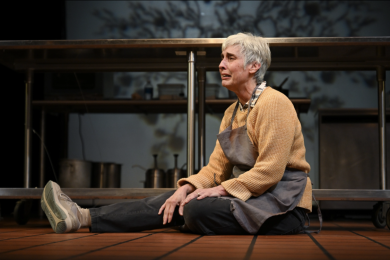Counterpoint

Editor's Note: Emilia contacted me in response to our original review of Dead Man Walking.
On Thursday evening, I saw MN Opera’s production of Dead Man Walking. I agree with the reviews I’ve read—the production was powerful: in particular, Seth Carico as Joseph De Rocher gave the best dramatic performance I’ve ever seen in an opera. The piece is indeed searing and urgent. But the MN Opera production also broke my heart in ways I didn’t anticipate. Perhaps I was naive to think that Angola Prison as recreated on the Ordway stage would bear any resemblance to real American prisons. However, I consider what I saw onstage on Thursday evening to be tantamount to a lie.
Louisiana State Penitentiary, known as Angola, is infamous. It’s the nation’s largest prison, housing well over 6,000 inmates, and has appeared in songs, books, and movies for decades. It’s a place of legendary violence and misery. And, in a reflection and exaggeration of national trends, the inmate population is over 75% black.[1] As of July 1 of last year, there were 73 Louisiana prisoners on death row. 48 of them were black.[2]
I make no claim to know the racial identity of any individual chorus member, and I certainly don’t intend to speak for the non-white cast members who were onstage on Thursday night. I own that I am making assumptions about the racial makeup of the cast based on my assessment of their appearances. My purpose is not to play a numbers game, or to perform white liberal self-righteousness. I can only imagine how unappealing it might be, as a black singer, to play a convicted murderer or an anonymous projects-dweller receiving Catholic charity. I also know that opera is still a largely white enterprise. But I also believe that, when portraying a place as notorious and as historically and culturally significant as Angola, it’s important to get it right, for a thousand social and artistic reasons. Those I saw onstage on Thursday night bore very little resemblance to the men sitting in Angola today.
How often does the average opera audience member spend three hours in an American prison? How often do we ask those who regularly visit the Ordway to consider those at the terminus of our justice system? However unpleasant it might be, the story of American prisons cannot be told without revealing significant, disproportionate racial disparities in every aspect of our criminal justice system, from traffic stops to incarceration to execution, and our society is indicted in that fact.[3] To deny this truth by omission is, however unintentionally, another instance of white Americans co-opting the black American experience for our own edification. By distorting the reality of American prisons, MN Opera allowed its audiences to sit comfortably in denial of that reality, and to view Dead Man Walking as the story of two white individuals exploring forgiveness and redemption. How much more powerful would this production have been if the audiences had been invited into a more accurate representation of the world of the piece—if the “little black children in the projects”[4] had really been black, if the curtain opened on dark-skinned bodies wearing identical, identity-stripping costumes and clinging to bars that restricted their movements and obscured their faces? What if the story of these two white people had been told at the center of a mass of black bodies, just outside the spotlights?
But the failure of MN Opera to more accurately reflect the world of the piece is not just a social failing; it is an artistic one.
Joseph De Rocher and the real prisoner upon whom that character is based, Elmo Patrick Sonnier, did not grow up in a colorblind society. De Rocher, we learn, grew up like so many of those who end up in our prisons: poor and with an unstable family life. And, though this is not in the libretto, it stands to reason that he learned the prejudice and justification that is the birthright of every white American, built into this nation at its founding: that no matter how badly off he was, at least he was not black.
This idea of enmity carefully constructed and maintained between black and poor white Americans is a central tenant of black American writing on race and, however unaware we may be, is at the core of our several definitions of “American.” Frederick Douglass[5], W. E. B. Du Bois[6], Dr. Martin Luther King, Jr., James Baldwin[7], and many other of our great black American thinkers have articulated it. Dr. King explained it thus:
If it may be said of the slavery era that the white man took the world and gave the Negro Jesus, then it may be said of the Reconstruction era that the southern aristocracy took the world and gave the poor white man Jim Crow. [. . .] And when his wrinkled stomach cried out for the food that his empty pockets could not provide, he ate Jim Crow, a psychological bird that told him that no matter how bad off he was, at least he was a white man, better than the black man.[8]
It is impossible to consider the soul of a poor, white, Southern, American criminal—which is what this opera asks us to do—without considering the racialized morass that formed him. For, in addition to the shame of poverty, the shame of a broken family, the shame of female rejection and horrific criminal acts and a death sentence, De Rocher ultimately knew the shame of facing the same fate as a disproportionate number of black American men. And yet, had De Rocher’s victims not been white, statistics tell us he would almost certainly have been spared the death penalty.[9]
Race is not incidental to this story. It is central to it. At some level, the production team knew this: the choice was made to tattoo not only a Confederate flag but a swastika onto the character of De Rocher. But if this was an attempt to acknowledge the racial reality from which De Rocher hailed, in the absence of black bodies onstage, it backfired. Even in 2018, when we have seen white men waving swastikas marching through American streets in a show of “pride,” the swastika, and to a lesser extent the Confederate flag, still signals to white Midwestern opera-going audiences that the character wearing such symbols can be dismissed as backwards and ignorant, holding distasteful ideas and far removed from our day-to-day life.
If only audiences, instead of seeing a hateful symbol painted onto white skin, had seen a closer approximation of the hateful reality hidden behind the walls of American prisons.
The production notes and marketing for this opera make no mention of race, and repeatedly, they go to great lengths to emphasize the universal appeal of this piece. Of course it is universal, like any great work of art; it is also undeniably, uniquely American. We are at a crucial moment in our life as a nation: we are being called upon to look honestly at the white supremacy and racism baked into our founding ideals, right alongside “all men are created equal,” and to decide what we will do about it. With Dead Man Walking, MN Opera had an opportunity and an obligation to reflect the truth, and it failed to do so. Each critic who has written glowingly about this production and ignored the dishonesty of Angola’s representation on the Ordway stage has also abdicated their responsibility to hold our artistic community to a higher standard of engagement. The rich and potent characters of Joseph De Rocher and Sister Helen Prejean, not to mention all the others in the piece, were painted less vividly than they might have been had they inhabited a more complex, and truthful, world.
And so as awed as I was by Thursday evening’s performance, my heart breaks for the black Americans whose stories have, once again and quite literally, been whitewashed. And my heart breaks for white Americans like me who continue to live in a contrived and whitewashed world that asks us, whether we are artist or audience, to be content to be “not-black.”
[1] https://www.theatlantic.com/politics/archive/2015/09/a-look-inside-angola-prison/404377/
[2] https://deathpenaltyinfo.org/race-death-row-inmates-executed-1976#Vic
[3] http://www.slate.com/articles/news_and_politics/crime/2015/08/racial_disparities_in_the_criminal_justice_system_eight_charts_illustrating.html
[4] http://www.warnerclassics.com/data_files/release_download/libretto_dead_man_walking_199.pdf
[5] http://rbscp.lib.rochester.edu/4391
[6] http://items.ssrc.org/beyond-the-wages-of-whiteness-du-bois-on-the-irrationality-of-antiblack-racism/
[7] http://www.nytimes.com/books/98/03/29/specials/baldwin-dream.html
[8] http://kingencyclopedia.stanford.edu/encyclopedia/documentsentry/doc_address_at_the_conclusion_of_selma_march/index.html
[9] https://www.unc.edu/~fbaum/articles/Louisiana-RaceOfVictim-LJPIL-Fall2015.pdf




